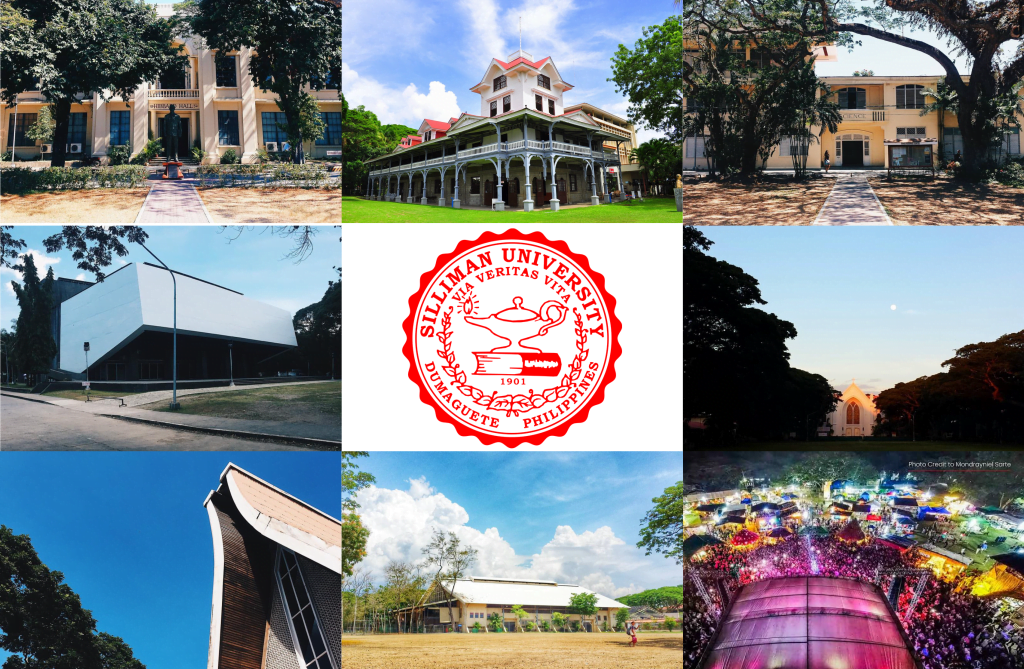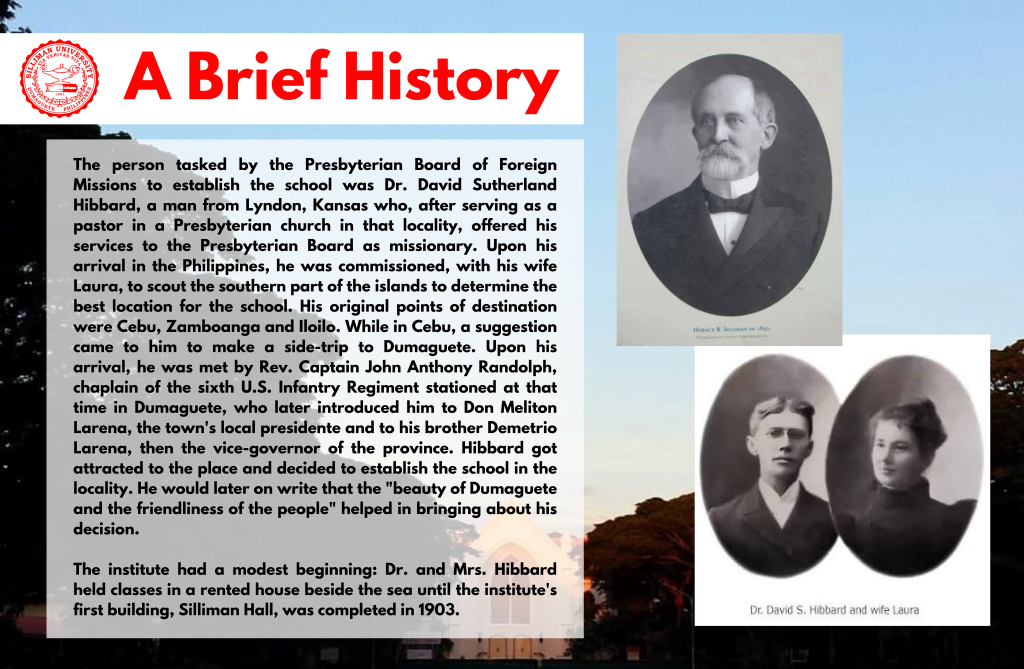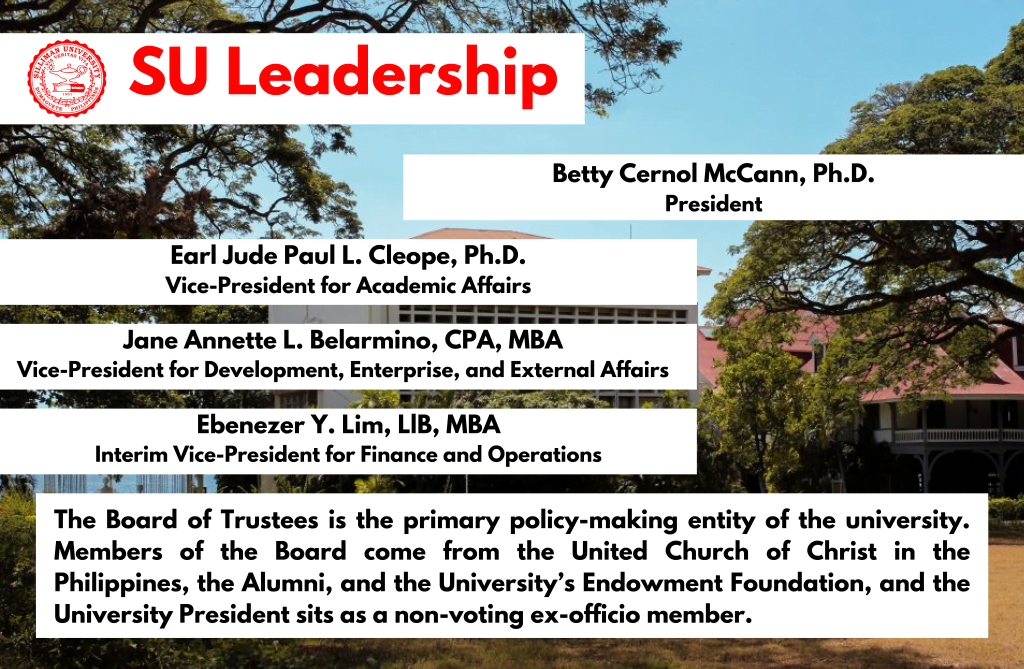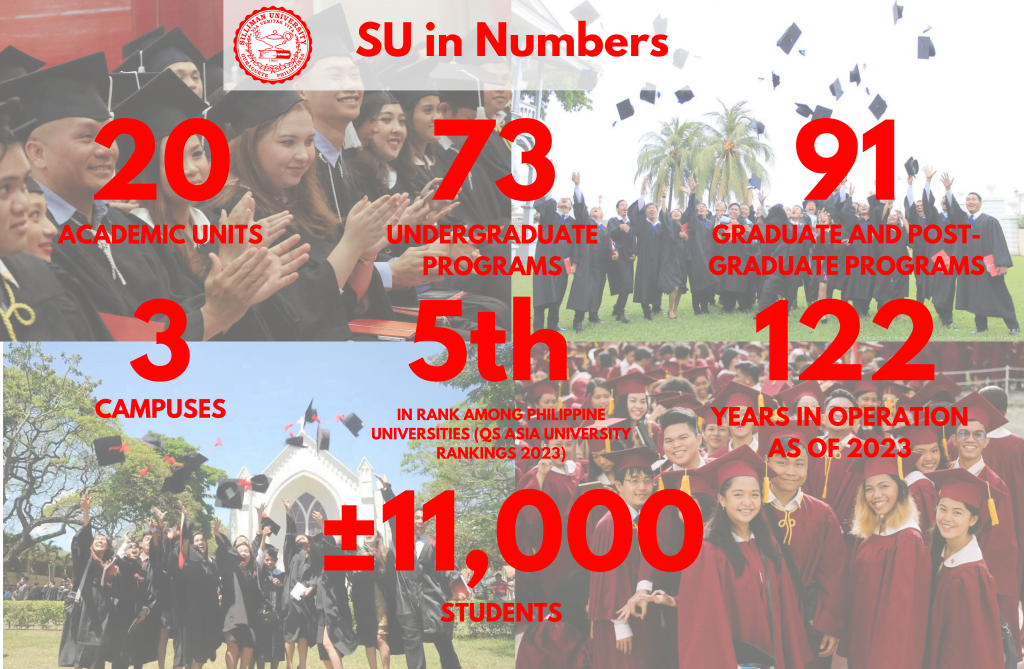
An Overview of SU
Founded in 1901 as a school for boys, Silliman Institute was established by missionary educators Dr. David Sutherland Hibbard and Laura Crooks Hibbard. This was made possible through a seed fund of $10,000 made by New York businessman and philanthropist Dr. Horace Brinsmade Silliman to the Board of Foreign Missions of the Presbyterian Church. The Hibbards had 15 boys to teach on their first morning. Little would they know that the small industrial school they started would grow into a melting pot of thousands of learners from all over the world.
Today, Silliman University holds the distinction as the oldest American-founded educational institution in the Philippines and a leader in the fields of Nursing Education and Allied Health Sciences; Teaching Education; Marine, Coastal, and Environment Management; Information Technology; Journalism; Arts and Sciences; and Business. SU has also produced alumni who are exemplars in the world of politics, health, law, engineering, music, fine arts, biology, and journalism.
SU’s Main Campus sits at the heart of Dumaguete City and serves as an oasis of lush greenery dotted by a mix of acacias and structures which have witnessed over a century of the city’s growth from a sleepy town to a city that has become a home for arts and culture in the central Philippines.
5Cs of Silliman University
For its brand of a holistic approach to education, Silliman centers the learning and development of its students in the 5Cs, five venues for learning outside the Classroom, the first “C”. The other Cs are the Church, Court, Culture, and Community.
The heart and soul of SU, its Christian identity and faith, the Church is vital to the formation of each Sillimanian, transcending religious affiliations and beliefs. In a nutshell, learning under the C of Church is simply instilling the Christian values of human compassion, sense of justice, care and stewardship for God’s creation, and respect for human dignity. Meanwhile, learning under the C of Community applies those values through service to the greater Silliman community both within and off-campus through the multitude of communities and localities the university serves. Learning under the C of Culture instills valuing the arts and everything it represents, taking advantage of the Luce Auditorium and other venues for cultural shows and presentations, Sillimanians are expected to develop a more profound appreciation for the arts. The C of the Court places an emphasis on maintaining a healthy and active lifestyle through various sports activities conducted in the campus including swimming, basketball, softball, recreational games, frisbee, among others.


Silliman Church
The beginnings of Silliman University Church date back to the coming of the American Presbyterian missionaries to the Philippines in 1899. Two years
later, they established the Dumaguete Mission Station in January of 1901. Seven months later, Dr. and Mrs. David and Laura Hibbard founded Silliman Institute.
At the start, the regular services in Silliman were organized together with the first classes. An outreach evangelical congregation in the town apparently
existed as early as 1903 but the plan to have a regular church organized materialized only upon the establishment of the Presbyterian Church of
Dumaguete on December 6, 1911. This church, which later would become known as the Dumaguete Evangelical Church, was composed of both the
Dumaguete townspeople and the Silliman Community. This event marked the official founding of a Protestant (Presbyterian) church in Dumaguete (later to be known as the Dumaguete Town Church).

However, because of the difficulty of maintaining under one structure two congregations (in the town and the school) which had different ministries and curricular interests and using different languages for worship and because the town church had become part of an independent Philippine Presbyterian
church apart from the Presbyterian churches in the United States to which, through the latter’s Board of Foreign Mission, Silliman continued to belong, the two groups eventually were reorganized as separate congregations in 1916 with Dr. Paul Doltz serving as the first Pastor of the Silliman Student Church. This church, the Student Church, eventually became the Silliman University Church – a church ministering to all Sillimanians, regardless of their denomination and religious affiliations.
Since its founding, Silliman Church had always had Silliman students, faculty, staff and alumni as its central concern. Its program had been a very active one putting emphasis on its evangelistic witness. Yet despite its Presbyterian background, the students are given the freedom to practice their own
religious beliefs and are instead provided with opportunities to broaden their spiritual horizon and translate their faith into active commitments.

Why SU?
SU is ranked among the top universities in the Philippines, and its alumni are highly successful in their careers. The university has a strong focus on research, and its faculty are active in publishing and collaborating with industry partners. SU also offers a variety of extracurricular activities, including sports, theatre, debate, regional, and socio-civic clubs, and the student government.
SU is home to programs that have been designated by the Philippines’ Commission on Higher Education as Centers of Excellence and Development. Its Nursing and Teacher Education programs are Centers of Excellence while its Medical Technology, Biology, and Information Technology programs are Centers of Development.
The university and the greater Dumaguete area is home to many activities for enthusiasts including coffee, food, freediving, mountaineering, trekking, music, visual and the performing arts, among many other fields of interest. The city where the campus is located is only a stone’s throw away from the bustling metropolis of Cebu, an hour away from the Philippine Capital, Manila, most importantly Dumaguete provides easy access to the natural wonders of Negros, Bohol, Siquijor, and Cebu islands.
The SU Main Campus is a sprawling 33-hectare oasis at the heart of Dumaguete and is home to the historic Silliman Hall, Silliman Library, the Claire Isabel McGill Luce Auditorium, and several structures considered as Dumaguete’s own historical gems.
3Ps of SU
During the investiture rites of the current University President, Dr. Betty Cernol McCann expressed her interest in an administration focused on three Ps: People, Programs, and Partners.
She envisions to reenergize the university’s role in society by positioning it as a champion for the environment and promoting whole-person education.
To achieve this vision, she plans to respond to the challenges of ending poverty and helping the planet survive and integrate environmental education in specific programs and promote environmental integrity on the planet. Promote multidisciplinarity and inclusiveness in education by breaking down and then bridging the silos between teaching, research, and community service. Thus, seeing the need to retool and reskill faculty and staff to better equip for the great tasks infront of them and finally, promote transparency and servant leadership. across all levels.
Dr. McCann believes that Silliman University has the potential to be a leader in whole-person education. She is excited to see what the Silliman community can accomplish in the years to come.

